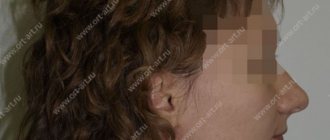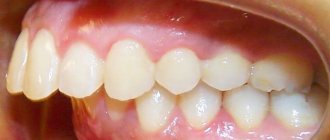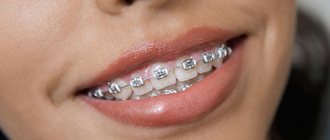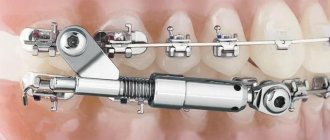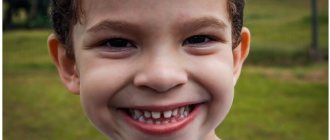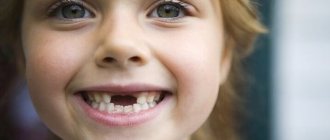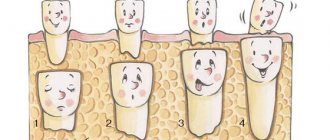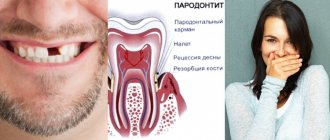What is transmitted genetically
Most diseases of the dental system are not 100% genetically dependent. However, there are signs that are passed on from generation to generation and can ultimately affect the condition of the teeth. These include:
- composition, thickness and shade of enamel;
- shape of dental units;
- bite geometry;
- timing of the eruption of primary and permanent teeth;
- composition of saliva and oral microflora.
Along with these characteristics, the child also inherits a predisposition to certain pathologies. But there is no fatality in this. With a reasonable, competent attitude to oral care, you can avoid the development of one or another disease, the likelihood of which is genetically predetermined.
Inheritance of malocclusion in dogs
For the success of breeding work with breeds of hunting dogs, it is necessary to adhere to certain zootechnical techniques.
However, in practice, some dog breeders and dog handlers do not take into account the basic laws of genetics when breeding hunting dogs . We know of cases when, in the section of German shorthaired pointing dogs, the MOOiR excluded and continues to exclude high breeding class sires from mating plans. So, for example, part Lada, exterior “excellent”, diplomas: two - I degree, one each - II and III degrees, owner G. T. Tushkan; Firs, exterior “very good”, diplomas: three - I degree, one each - II and III degrees, excluded from breeding plans due to the fact that one offspring with an incorrect bite (underbite) was found in Part Lada, and Firs 1135/kl is excluded because his grandmother is N. Lada G. T. Tushkan and great-grandfather Dick I. I. Yakovleva were heterozygous for bite, that is, they carried the malocclusion gene in a latent form.
The mentioned dogs, Parts Lada and Firs, came from an outstanding sire, six-time champion, founder of the breeding line of short-haired pointing dogs in our country, Dick I. I. Yakovlev, who carried the latent malocclusion gene and passed it on to his offspring.
Arguments for excluding sires valuable for the breed from mating plans on the basis of a heterozygous trait cannot serve as a sufficient basis, since they are only a speculative conclusion, which is based on a false idea of the genetic principles of breeding work with breeds of hunting dogs.
Let's try, based on the laws of genetics , to prove that homogeneous heterozygous pairs of animals that carry the latent malocclusion gene can participate in breeding reproduction when culling individuals with malocclusion.
The solution to the problem is carried out as follows. Eight dogs were conditionally taken as the ancestors of the population; all of them are heterozygous and carry the latent malocclusion gene. Of these eight dogs, four pairs are formed. With an average fertility of six puppies, they will produce 24 dogs in the first generation (4x6 = 24).
In accordance with Mendel's law, these descendants will consist of the following groups of animals : 1/4 homozygous with normal occlusion; 1/2 heterozygous and 1/4 homozygous with malocclusion, that is, six homozygous dogs will be obtained that do not carry the latent malocclusion gene, and six dogs with malocclusion. We reject six dogs with malocclusion, the remaining 18 dogs are accepted to mating, we make up nine breeding pairs from them, which will produce 54 dogs (9x6=54) of the second generation.
This population, according to Mendel's law, will consist of the following groups of animals: 27 dogs (50%) homozygous with normal bite, 18 dogs (33%) heterozygous and 9 dogs (17%) with malocclusion, which must be culled.
Continuing similar research until the sixth generation, we obtain data according to which the number of livestock in the sixth generation will be 2844 dogs. Including: 2718 dogs (96%) homozygous with normal bite, 84 dogs (2.5%) heterozygous, 42 dogs (1.5%) with malocclusion.
From the above problem it is clear that the number of dogs homozygous (with normal bite) in the breed tends to 100%, and heterozygous dogs with malocclusion tends to zero (considering that breeding is carried out under the constant supervision of the breeder).
Based on the given examples of the pattern of inheritance of malocclusion in dogs during the development of the population, the following conclusions can be drawn.
It is unacceptable to use dogs with malocclusion in breeding , as this leads to a significant increase in the number of livestock with a similar defect.
Dogs that have a correct bite, but carry the heredity of a malocclusion, can be used as breeding studs if, according to their comprehensive assessments, they meet the requirements of the guidelines for conducting breeding work with breeds of hunting dogs. At the same time, you should not repeat matings of pairs from which offspring with malocclusion were found in the litters.
Excluding heterozygous dogs from mating is a big mistake, since this may exclude dogs of high breeding classes from breeding, which will lead to a deterioration in the quality of the breed.
The above examples of patterns of inheritance make it possible to reduce the number of livestock with undesirable deviations from the standard of hunting dog breeds in subsequent generations.
When rejecting undesirable phenotypes of dogs, a genetic restructuring occurs in each subsequent generation , which reduces the specific number of those carrying atypical heredity in the offspring, for example, the elimination of deficiencies and defects in the type of constitution and exterior, atypical coat color, non-standard height and eye color, and so on.
From the above examples it is clear that, by wisely using genetic science, a dog handler can control the heredity of animals and transform traits in the right direction depending on the assigned tasks, the condition of the livestock and the prospects for the development of the breed.
Source: A. Petrov, expert dog handler of the first category
Structure of teeth
In the presence of a thin layer of enamel on the teeth and deep fissures (slit-like depressions on the chewing surface), the risk of early carious tooth destruction increases. But even with hereditary weakness of the enamel, it will be reliably protected:
- careful hygienic care;
- carrying out remineralization of enamel (saturation with calcium and fluoride salts);
- fissure sealing (sealing with a composite material immediately after teeth erupt).
At the Shifa clinic, children can always get help in strengthening hard dental tissues.
Diagnostics
The picture clearly shows the problem
Patients with a similar problem will have to undergo examination not only by the dentist, but also by other specialists - speech therapist, ENT specialist, etc.
Standard orthodontic methods used for diagnosis:
- X-ray image;
- visual examination of the patient;
- occlusion assessment;
- conducting a functional test;
- The severity of the problem is measured using bite rollers.
Based on the results of the examination, a final diagnosis is made and appropriate treatment is prescribed. In the video in this article you can see how the examination is carried out.
Composition of saliva
When parents complain about bad teeth, they often do not realize that the cause may be the composition of saliva, which determines heredity. It may vary in the ratio of mineral and organic components. And this has a direct impact on dental health.
With a reduced content of oligosaccharides in saliva, the population of microorganisms increases, which settle on the surface of the enamel, creating a predisposition to caries. To avoid this disease, you need to brush your teeth at least twice a day and use special mouthwashes.
An increase in the concentration of class A immunoglobulins (IgA) in saliva, which have an antibacterial effect, protects the enamel from cariogenic bacteria.
The specialists of the Shifa clinic will help you choose toothpaste and other hygiene products to create the right environment in the oral cavity. Dentists will also give recommendations on diets that reduce the negative effects of saliva.
Bad teeth are inherited
How easy it is to justify another filling by saying that your parents have 10 in each tooth. Of course, heredity can affect the size, structure of the tooth and tissue resistance to diseases, however, all these shortcomings are compensated by proper care.
Chewing gum freshens your breath - they say this in advertising, promising that girls will rush to kiss you while you chew. Chewing gum will certainly help eliminate odors caused by certain foods, such as onions or hot sauce. But it is powerless against amber, which is permanent and whose cause is diseases of the mouth or internal organs.
Halitosis (as dentists diplomatically call bad breath) is a very common phenomenon. By the way, almost all people suffering from halitosis do not even suspect it. Our breathing apparatus is designed in such a way that we cannot smell our own smell. Therefore, you should not hate this nasty colleague with bad breath - he vegetates in blind ignorance.
Bite
Abnormal bite often causes:
- increased load on individual teeth, which contributes to their rapid destruction or damage to the ligamentous apparatus;
- crowding of teeth, leading to gum inflammation and dental caries.
- The hereditary factor is detected in no more than 50% of cases of abnormal structure of the dental system. The remaining 50% is due to the following circumstances:
- artificial feeding;
- formation of bad habits at an early age (sucking pacifiers, fingers, lips, holding pencils or pens in the mouth);
- the habit of sleeping in one position, especially with your hand under your cheek;
- incorrect posture;
- lack of calcium and other trace elements in the body.
In preventing the development of pathological occlusion, the role of parents is great, who should pay attention to the early identification and elimination of provoking factors.
Human fangs: how to remove them?
- The easiest and shortest way is grinding. In this procedure, the protruding ends of the teeth will be removed and shortened. The doctor will cover the top of the tooth with special enamel. Among the advantages of the method are speed and painlessness. Among the disadvantages is that sharp edges will remain in any case, and you will have to get used to them - and incorrect development of the bite is not excluded.
- The highest quality alternative with virtually no negative consequences is orthodontic treatment with braces. This is especially recommended for teenagers under 18 years of age - at this age the jaw is not yet fully formed, and many things can be corrected in the shortest possible time. For adults, this process takes much longer (the system can be worn for up to two years), and is not always possible - a specialist can advise you more precisely.
- In addition, there are other, very effective methods for correcting fangs. This includes surgery, laser correction and more. Often such treatment is more expensive, but much less time will be spent on it than on correction with braces.
Of course, there are situations when removal of the fang is the only way out - for example, if it is severely damaged. However, any doctor will try to do everything possible to save your teeth. If the presence of fangs confuses you from a visual point of view, you will probably be interested in the fact that special fang extensions are very common among young people.
Most of us try not to visit doctors again, much less fight childhood fears and go for routine examinations to scary dentists. Most often, we make do with the advice of television dentists who don’t put their devilish tricks in our mouths. However, in fact, a decrease in life expectancy and aging is partly due to inflammatory processes in the oral cavity.
https://www.youtube.com/watch?v=ytcopyrightru
We suggest you read: Checking a car for registration bans - how to check a car in 5 minutes
With periodontitis, microorganisms and their metabolic products negatively affect the periodontal tissue and gums, destroying them. With the blood flow, like a virus, from the oral cavity these same products are spread throughout the body, which causes general inflammation. Pathogenic bacteria and their toxins reach vital organs (heart, lungs, kidneys, etc.), and this entails the development of chronic diseases. Scary? Now live with this knowledge.
According to statistics, this tedious task takes the average person about 46 seconds. Unfortunately, for the sake of your health, you will have to make an effort and endure your sleepy face with foam at the mouth for at least 2 minutes. And this is just the time allotted for brushing your teeth! After all, where there are teeth, there is usually a tongue, which also needs to be cleaned.
But this is not enough. The inside of your cheeks is also a cozy home for bacteria that destroy your body. Nothing is sacred to these little bastards. Bacteria cause periodontal disease, microorganisms and their metabolic products destroy the periodontal tissue and gums, and also release toxins that spread throughout your body and destroy it. We hope we've scared you enough that your next mouth cleaning will take you longer than 46 seconds.
Our expert insists that for high-quality oral hygiene you should use a complete set: a toothbrush, interdental brushes, floss and toothpastes. If there are no serious problems, then a complex paste with a mandatory fluoride content is recommended for everyday use. An advantage for the paste will be the Triclosan/Copolymer content. The first one kills bacteria, and the second one actively helps it in this.
The importance of prevention
The child subconsciously adopts the behavior and habits of his parents. If older family members do not brush their teeth, eat improperly, or do not exercise, then dental diseases lie in wait for both adults and children. At the same time, the incorrect conclusion is often made that “bad teeth are inherited.”
Mineralization of dental tissue continues after teething. Any disease, weakened immune system, or unbalanced diet have a much greater impact on the hard tissues of teeth than hereditary predisposition.
Parents should monitor the health of their children by providing them with proper care and disease prevention. This will help avoid dental caries and the development of enamel hypoplasia, and reduce the risk of abnormal bite.
In case of poor heredity, timely prevention plays a key role. Regular dental care will reduce the risk of developing dental and periodontal disease in children. The specialists of the Shifa clinic are always ready to help. Our dentists regularly improve their professionalism, conduct diagnostics and treatment using modern equipment. This allows you to identify possible risks and prevent them in a timely manner. Contact professionals to ensure your child’s teeth are always strong and healthy!
Signs of a tendency to caries in children
In medicine, it is customary to distinguish between patients with an increased risk of caries (caries-prone) and those who are less susceptible to the disease (caries-resistant).
The first symptoms of predisposition to the disease appear in childhood. Here's what to pay attention to:
- viscous saliva - for example, in a child it stretches from the mouth like an elastic thread;
- complaints of a constant feeling of sourness in the mouth;
- delayed eruption (retention) – a delay in the appearance of temporary teeth by six months or more, and permanent teeth by a year or more;
- pathologies of the formation and development of dental tissues - when teeth grow defective, with various visible defects;
- The child takes proper care of his teeth, rinses his mouth after eating, but a heavy accumulation of plaque on the enamel still occurs.
